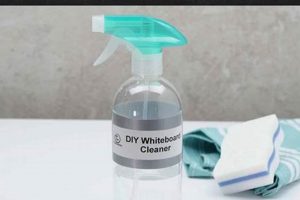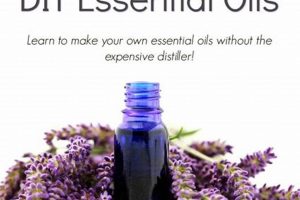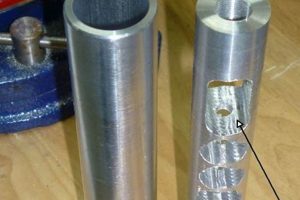A customized growing medium, created from individual components rather than purchased pre-mixed, provides plants with necessary nutrients and support. Gardeners often formulate these blends to meet the specific needs of different plant species. An example includes a blend of peat moss, perlite, and vermiculite for general use, or a mix incorporating coconut coir and compost for moisture retention and enhanced fertility.
The practice of preparing tailored soil alternatives offers several advantages. It can be more cost-effective, especially when cultivating a large number of plants. Furthermore, blending ingredients allows for control over the medium’s composition, ensuring it is free from unwanted additives or pathogens. Historically, horticulturists have manipulated growing mediums to optimize plant growth and development, experimenting with various materials to achieve specific drainage, aeration, and nutrient availability characteristics.
Understanding the individual components and their respective roles is paramount for successful plant cultivation. The following sections will delve into the common ingredients, formulation techniques, and applications for diverse horticultural needs. This detailed exploration will empower individuals to create optimal growth conditions for their plants.
Essential Guidelines for Soil Alternative Preparation
Optimizing plant growth requires careful consideration of the growing medium. The following guidance will assist in formulating effective soil alternatives for diverse horticultural applications.
Tip 1: Select Quality Components: Begin with high-quality ingredients such as screened compost, horticultural-grade perlite, and well-aged peat moss or coconut coir. Avoid using garden soil, as it can harbor pathogens and impede drainage.
Tip 2: Prioritize Drainage: Incorporate materials that enhance drainage, such as perlite, vermiculite, or coarse sand. Proper drainage prevents root rot and ensures adequate aeration.
Tip 3: Ensure Adequate Aeration: Aeration is crucial for root respiration. The inclusion of materials like perlite or bark fragments creates air pockets within the medium.
Tip 4: Balance Nutrient Content: Compost is an excellent source of slow-release nutrients. Supplement with organic fertilizers such as bone meal or kelp meal to address specific nutritional needs.
Tip 5: Adjust pH Levels: Certain plants require specific pH ranges. Use a soil testing kit to determine the pH and amend accordingly with lime (to raise pH) or sulfur (to lower pH).
Tip 6: Sterilize Components When Necessary: For seedling starting or plants susceptible to soilborne diseases, sterilize components by baking or steaming. This reduces the risk of damping-off and other fungal infections.
Tip 7: Test Small Batches: Before potting a large number of plants, test the formulated medium with a few plants to assess its suitability. Monitor plant growth and adjust the formula as needed.
Properly formulated soil alternatives provide a balanced environment for root development and nutrient uptake, leading to vigorous plant growth and increased yields. Adherence to these guidelines contributes to successful horticultural practices.
The concluding sections will address specific formulations for various plant types and common troubleshooting techniques. This comprehensive approach ensures optimal utilization of custom-made growing mediums.
1. Ingredient Selection
Ingredient selection forms the foundational basis for a successful customized soil alternative. The specific components chosen directly influence the physical and chemical properties of the growing medium, impacting root development, nutrient availability, and overall plant health. For instance, selecting a heavy clay-based substance will invariably impede drainage, potentially leading to root rot. Conversely, excessive reliance on coarse sand can result in rapid water loss, hindering nutrient uptake. The selection process, therefore, necessitates a thorough understanding of each ingredient’s characteristics and how they interact within the final blend. The choice of compost, peat moss, perlite, vermiculite, and other amendments determines the final texture, water-holding capacity, and nutrient profile.
Consider, for example, the cultivation of acid-loving plants like blueberries or azaleas. A suitable soil alternative requires the inclusion of acidic components, such as peat moss or pine bark, to maintain the appropriate pH level. Substituting these with alkaline materials would detrimentally affect the plant’s ability to absorb essential nutrients, resulting in chlorosis and stunted growth. Similarly, when preparing a medium for succulents, incorporating materials like perlite or pumice is crucial for ensuring proper drainage and preventing waterlogged conditions that can cause root decay. Incorrect selection inevitably leads to compromised plant health and reduced yield.
In summary, ingredient selection dictates the ultimate success or failure of a customized soil alternative. By carefully evaluating the properties of each component and tailoring the blend to the specific requirements of the plants being cultivated, individuals can create an optimal growing environment that promotes vigorous growth and maximizes productivity. Understanding this connection is vital for achieving desired horticultural outcomes.
2. Drainage properties
Effective drainage constitutes a critical factor in the formulation of a custom soil alternative. The degree to which a growing medium permits excess water to flow away from plant roots directly impacts their health and function. Insufficient drainage results in waterlogged conditions, reducing oxygen availability to the roots and promoting anaerobic bacterial growth. This environment leads to root rot, nutrient deficiencies, and ultimately, plant decline. Conversely, excessively rapid drainage can cause the medium to dry out too quickly, hindering nutrient uptake and subjecting the plant to water stress. Therefore, precisely controlling drainage is paramount for optimizing plant growth. The composition of the growing medium dictates its drainage characteristics. Components such as perlite, vermiculite, and coarse sand increase porosity, facilitating water movement. Conversely, fine particles, such as clay or silt, retain water, reducing drainage. An appropriate balance of these components ensures that the medium retains sufficient moisture for plant use while allowing excess water to escape.
Consider, for example, the formulation of a growing medium for container-grown vegetables. These plants typically require a well-draining medium to prevent root rot and ensure optimal nutrient availability. A mix consisting primarily of peat moss or coconut coir, without the addition of drainage-enhancing amendments, is likely to retain too much water, leading to anaerobic conditions an
d potential crop failure. Conversely, a medium composed solely of coarse sand would drain too rapidly, requiring frequent watering and potentially causing nutrient leaching. A balanced blend, incorporating peat moss or coconut coir for water retention, perlite or vermiculite for drainage, and compost for nutrient supply, would provide an optimal environment for root development and plant growth. The specific proportions of each component can be adjusted based on the specific needs of the vegetable species being cultivated.
In conclusion, appropriate drainage properties are essential for a successful custom soil alternative. The careful selection and blending of components to achieve optimal drainage characteristics is crucial for preventing root diseases, ensuring adequate nutrient availability, and promoting vigorous plant growth. The understanding and management of drainage contribute significantly to the overall success of horticultural endeavors.
3. Aeration
Aeration, the provision of air spaces within the growing medium, constitutes a fundamental factor in the success of self-prepared soil alternatives. Plant roots, like other living organisms, require oxygen for respiration, the process by which they convert sugars into energy. In the absence of sufficient oxygen, root function declines, leading to impaired nutrient uptake, reduced water absorption, and ultimately, plant stress or death. Adequate aeration within a customized soil alternative ensures that oxygen reaches the roots, facilitating healthy growth and development. This is achieved by incorporating materials that create air pockets within the mix, preventing compaction and promoting gas exchange between the roots and the surrounding environment. The physical properties of the components directly influence aeration; for example, adding perlite or bark fragments to the mix increases porosity and improves air circulation.
The consequences of poor aeration are evident in various scenarios. Consider a growing medium consisting solely of finely ground peat moss. While peat moss possesses excellent water-holding capacity, its fine texture can lead to compaction, reducing air spaces and inhibiting root respiration. Plants grown in such a medium often exhibit stunted growth, yellowing leaves, and increased susceptibility to root diseases. Conversely, a well-aerated mixture, amended with materials such as perlite or coarse sand, allows for sufficient oxygen diffusion, promoting vigorous root growth and enhanced nutrient uptake. For instance, orchids, which are epiphytic plants that naturally grow on tree bark, require exceptionally well-aerated growing mediums. A customized soil alternative for orchids typically includes large bark chunks, charcoal, and perlite to provide ample air circulation around the roots, preventing rot and promoting healthy growth.
In summary, aeration constitutes a critical component of any customized soil alternative. By carefully selecting and blending components that promote air spaces within the medium, individuals can ensure that plant roots receive the oxygen necessary for optimal respiration and nutrient uptake. This understanding is essential for preventing root diseases, promoting vigorous growth, and achieving successful horticultural outcomes. The careful management of aeration, therefore, is inextricably linked to the overall health and productivity of plants grown in self-prepared soil alternatives.
4. Nutrient balance
Nutrient balance constitutes a critical aspect of formulating a do-it-yourself (DIY) potting mix. Plants require a range of essential nutrients, including macronutrients such as nitrogen, phosphorus, and potassium, as well as micronutrients like iron, manganese, and zinc, for optimal growth and development. A deficiency or excess of any of these nutrients can lead to various physiological disorders and reduced plant vigor. The primary advantage of creating one’s own growing medium lies in the ability to precisely control the nutrient content, tailoring it to the specific needs of the plants being cultivated. Unlike commercially available mixes, which may contain a generic blend of nutrients, a customized blend allows for the incorporation of specific amendments to address the particular requirements of different plant species or growth stages. For example, a DIY mix for tomatoes, which are heavy feeders, may include higher levels of phosphorus to promote fruit development, while a mix for succulents, which are adapted to nutrient-poor environments, may contain minimal nutrient supplementation.
Achieving optimal nutrient balance in a DIY potting mix requires a comprehensive understanding of plant nutrition and the properties of various organic and inorganic amendments. Compost serves as a valuable source of slow-release nutrients, providing a balanced blend of macronutrients and micronutrients. However, the nutrient content of compost can vary depending on the source materials and composting process. The addition of specific amendments, such as bone meal (for phosphorus), blood meal (for nitrogen), or kelp meal (for micronutrients), allows for fine-tuning the nutrient profile of the mix. It is also important to consider the pH of the growing medium, as pH affects the availability of certain nutrients to plants. For instance, iron is more readily available in acidic soils, while phosphorus availability decreases at high pH levels. Therefore, adjusting the pH of the DIY potting mix with amendments like lime or sulfur can ensure optimal nutrient uptake.
In summary, nutrient balance represents a critical consideration in DIY potting mix formulation. By carefully selecting components and incorporating appropriate amendments, individuals can create a customized growing medium that provides plants with the essential nutrients they need for healthy growth and abundant yields. While challenges exist in accurately assessing nutrient levels and adjusting the mix accordingly, the ability to tailor the nutrient profile to specific plant needs offers a significant advantage over commercially available alternatives. Proper nutrient management, coupled with appropriate drainage and aeration, forms the foundation for successful plant cultivation using custom-made soil alternatives.
5. pH adjustment
The process of pH adjustment is intrinsic to the successful formulation of a do-it-yourself potting mix. Soil pH, a measure of acidity or alkalinity, profoundly influences nutrient availability to plants. A pH outside the optimal range for a given species results in nutrient lockout, irrespective of the presence of those nutrients within the medium. Consequently, plants exhibit deficiency symptoms, hindering growth and productivity. For example, azaleas and blueberries thrive in acidic conditions (pH 4.5-5.5), where iron and other micronutrients are readily available. A DIY potting mix lacking appropriate acidification through amendments like peat moss or sulfur would impede nutrient uptake, causing chlorosis (yellowing of leaves) and stunted development, despite adequate nutrient levels. Conversely, vegetables like lettuce and spinach prefer slightly alkaline conditions (pH 6.0-7.0).
The adjustment of pH within a customized growing medium involves careful selection and incorporation of amendments. Lime, derived from ground limestone, increases pH, counteracting a
cidity. Elemental sulfur, through microbial conversion in the soil, generates sulfuric acid, lowering pH and increasing acidity. The quantity of amendment required depends on the initial pH of the components and the buffering capacity of the mix. Accurate pH measurement using a soil testing kit is essential for informed adjustment. Furthermore, the stability of the pH over time must be considered. Organic matter decomposition can alter pH, necessitating periodic monitoring and re-adjustment. For instance, the decomposition of compost can initially increase pH, followed by a gradual decrease as organic acids are released.
In summary, pH adjustment constitutes an indispensable step in crafting a DIY potting mix tailored to specific plant needs. Neglecting pH considerations leads to nutrient imbalances and impaired plant health, undermining the benefits of a customized growing medium. Understanding the interplay between pH, nutrient availability, and plant physiology empowers individuals to optimize growing conditions, maximizing plant growth and productivity. This careful attention to pH enables individuals to create a tailored environment, ensuring plants can effectively absorb the nutrients required for thriving, leading to enhanced horticultural outcomes.
6. Sterilization
Sterilization, in the context of a self-prepared growing medium, represents a crucial process aimed at eliminating or significantly reducing harmful microorganisms, weed seeds, and insect larvae. These undesirable elements, if present, can inhibit seed germination, cause plant diseases such as damping-off, and compete with plants for nutrients, ultimately compromising growth and yield. Sterilization serves as a preventative measure, particularly vital when utilizing components sourced from locations with potential contamination, such as compost derived from an unknown origin or garden soil intended for repurposing. The absence of sterilization introduces a heightened risk of introducing pathogens that can decimate seedling populations or weaken established plants, leading to significant horticultural losses. For instance, using unsterilized garden soil in a seed-starting mix can introduce fungal spores responsible for damping-off, a fatal disease that affects young seedlings, causing them to collapse and die.
Several methods exist for sterilizing soil components, including heat treatment through baking or steaming. Baking involves heating the moistened medium in an oven to a specific temperature (typically 180-200F) for a designated period (usually 30-60 minutes), effectively killing most harmful organisms. Steaming employs a similar principle, utilizing steam generated from boiling water to heat the medium. While effective, heat sterilization can also eliminate beneficial microorganisms, potentially disrupting the natural balance of the soil ecosystem. Therefore, it is crucial to avoid excessive heating and consider reintroducing beneficial microbes through amendments like compost tea after sterilization. Chemical sterilization, utilizing products such as formaldehyde, is another option but is generally discouraged due to environmental concerns and potential risks to human health. The choice of sterilization method depends on the scale of operation, the type of components used, and individual preferences.
In summary, sterilization is an integral step in the preparation of a customized growing medium, mitigating the risk of introducing harmful organisms that can impede plant growth. While sterilization eliminates potential threats, it also requires careful consideration to minimize disruption to beneficial microbial populations. The implementation of appropriate sterilization techniques, combined with sound horticultural practices, contributes significantly to the creation of a healthy and productive growing environment. Although some advocate for not sterilizing due to the disruption of the natural biome, the specific needs of the plants and risks associated with non-sterilized components will ultimately determine the need for sterilization.
7. Customization
Customization is intrinsic to the value proposition of a do-it-yourself potting mix. The ability to tailor the growing medium to the specific needs of a plant species represents a significant advantage over commercially available, generalized mixes. Standardized formulations often fail to account for the diverse requirements of various plant types, leading to suboptimal growth. For instance, orchids, which are epiphytic plants adapted to growing on tree bark, require a highly aerated medium with excellent drainage, whereas moisture-loving ferns thrive in a water-retentive and nutrient-rich mix. A generalized potting mix would likely prove inadequate for either of these plant types. A customized approach allows for precise control over factors such as drainage, aeration, pH, and nutrient content, ensuring that each plant receives the ideal environment for optimal growth and development.
The practical applications of customized growing mediums extend to various horticultural contexts. In seedling propagation, a sterile, fine-textured mix with balanced nutrients promotes rapid root development and minimizes the risk of damping-off disease. For container gardening, customized mixes can be formulated to optimize water retention, aeration, and nutrient availability, reducing the need for frequent watering and fertilization. Furthermore, specific amendments can be incorporated to address unique challenges. For example, incorporating mycorrhizal fungi into a customized mix can enhance nutrient uptake, particularly phosphorus, in phosphorus-deficient soils. Similarly, adding slow-release fertilizers can provide a sustained supply of nutrients over an extended period. The ability to fine-tune the growing medium based on specific environmental conditions and plant requirements maximizes the efficiency of resource utilization and promotes plant health.
In conclusion, customization is not merely an optional add-on but a core principle of DIY potting mix formulation. By understanding the specific needs of plants and tailoring the growing medium accordingly, individuals can create an optimal environment for growth and development. Challenges exist in accurately assessing plant nutrient requirements and sourcing high-quality components; however, the benefits of a customized approach far outweigh the complexities. The ability to fine-tune growing conditions based on individual plant needs and environmental factors makes the process a powerful tool. The principles of customization, when applied judiciously, result in enhanced plant vigor, increased yields, and reduced reliance on chemical inputs.
Frequently Asked Questions
The following addresses common inquiries regarding the creation and utilization of customized plant-growth substrates.
Question 1: What are the primary advantages of formulating one’s own growing medium compared to purchasing commercially available mixes?
Formulating a growing medium offers increased control over ingredient composition, ensuring suitability for specific plant needs. This approach can also prove more cost-effective, particularly for large-scale cultivation or for growers requiring specialized blends not readily available commercially.
Question 2: Is it advisable to incorporate garden soil directly into a customized growing medium?
Direct inclusion of garden soil is generally discouraged due to potential pathogen presence, inconsistent drainage
properties, and compaction issues. Amended or sterilized garden soil may be considered in certain contexts, but caution is advised.
Question 3: How does one determine the appropriate pH level for a customized growing medium?
The optimal pH range varies depending on the plant species. Soil testing kits provide an accurate assessment. Adjust pH levels with amendments such as lime (to increase pH) or sulfur (to decrease pH) as needed to match the specific requirements.
Question 4: What role does sterilization play in the preparation of a customized growing medium?
Sterilization minimizes the risk of introducing harmful microorganisms, weed seeds, and insect larvae. Heat sterilization (baking or steaming) is a common method, though it can also eliminate beneficial microbes. Sterilization practices vary based on the specific plant needs.
Question 5: How can one ensure adequate drainage in a customized growing medium?
Incorporate components such as perlite, vermiculite, or coarse sand to enhance porosity and facilitate water movement. Adjust the proportions of these components based on plant-specific drainage requirements. Note that particle size affects drainage.
Question 6: What organic and inorganic amendments improve nutrient balance?
Achieving a good nutrient level includes both organic and inorganic. Compost provides slow-release nutrients, while fertilizers such as bone meal (phosphorus), blood meal (nitrogen), or kelp meal (micronutrients) can supplement. Balance is critical and testing is recommended.
Mastering the principles of formulation empowers individuals to create optimal environments for diverse plant species. By understanding component properties and plant requirements, growers can maximize plant health and productivity.
The ensuing sections will delve into common challenges and troubleshooting techniques associated with custom-made plant growth blends. A future addendum will also list some common safe ingredient types.
The Significance of “diy potting mix”
This exploration of customized plant growth mediums underscores the pivotal role of informed component selection and precise formulation. The inherent ability to manipulate drainage, aeration, nutrient availability, and pH levels offers substantial advantages over pre-mixed commercial alternatives. Mastery of these factors is critical for optimizing plant health and maximizing yield across a wide spectrum of species and growing conditions.
Continued advancement in horticultural practices necessitates an ongoing commitment to understanding plant-specific requirements and the nuanced interactions between various substrate components. The future of sustainable cultivation hinges on the adoption of tailored approaches that minimize resource waste and promote healthy plant growth. Further research is warranted to refine best practices and unlock the full potential of custom-made growing mediums in both amateur and professional settings.







